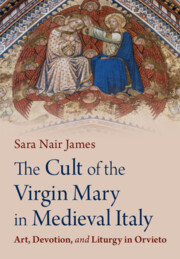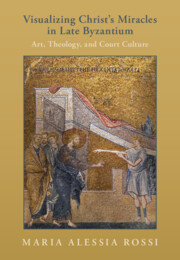Refine search
Actions for selected content:
82 results
Embedded Glottograms in the Images of the Gods in Ancient Central Mexico
-
- Journal:
- Ancient Mesoamerica , First View
- Published online by Cambridge University Press:
- 08 October 2025, pp. 1-22
-
- Article
- Export citation
18 - Glass
- from Part II - Artefacts and Evidence
-
- Book:
- The Cambridge Encyclopaedia of Late Antique Art and Archaeology
- Published online:
- 04 July 2025
- Print publication:
- 31 July 2025, pp 349-359
-
- Chapter
- Export citation
16 - Wall Painting
- from Part II - Artefacts and Evidence
-
- Book:
- The Cambridge Encyclopaedia of Late Antique Art and Archaeology
- Published online:
- 04 July 2025
- Print publication:
- 31 July 2025, pp 300-319
-
- Chapter
- Export citation

The Cult of the Virgin Mary in Medieval Italy
- Art, Devotion, and Liturgy in Orvieto
-
- Published online:
- 24 July 2025
- Print publication:
- 24 July 2025
Los cautivos tempranos de Oxpemul: Nuevas interpretaciones
-
- Journal:
- Latin American Antiquity / Volume 36 / Issue 1 / March 2025
- Published online by Cambridge University Press:
- 26 February 2025, pp. 222-238
- Print publication:
- March 2025
-
- Article
-
- You have access
- Open access
- HTML
- Export citation
Chapter 1 - Forging Literary Connections
- from Part I - Protest
-
- Book:
- Vivisection and Late-Victorian Literary Culture
- Published online:
- 30 January 2025
- Print publication:
- 06 February 2025, pp 23-48
-
- Chapter
- Export citation

Visualizing Christ's Miracles in Late Byzantium
- Art, Theology, and Court Culture
-
- Published online:
- 09 January 2025
- Print publication:
- 27 June 2024
Chapter 7 - Le Corbusier’s Impassive Partition Monument
-
- Book:
- Modernism and the Idea of India
- Published online:
- 02 January 2025
- Print publication:
- 09 January 2025, pp 159-180
-
- Chapter
- Export citation
6 - Making Children Subjects of Empire
- from Part II - Themes in the Making of Hegemony
-
- Book:
- Religion and the Making of Roman Africa
- Published online:
- 24 October 2024
- Print publication:
- 07 November 2024, pp 229-269
-
- Chapter
- Export citation
HERCULES SLAYING CACUS IN THE HYPOGEUM OF THE VIA DINO COMPAGNI, ROME
-
- Journal:
- Greece & Rome / Volume 71 / Issue 2 / October 2024
- Published online by Cambridge University Press:
- 31 October 2024, pp. 264-286
- Print publication:
- October 2024
-
- Article
-
- You have access
- Open access
- HTML
- Export citation
3 - Christ’s Miracles
-
- Book:
- Visualizing Christ's Miracles in Late Byzantium
- Published online:
- 09 January 2025
- Print publication:
- 27 June 2024, pp 47-144
-
- Chapter
- Export citation
Chapter 11 - Golden Locks Among the Greeks, or the Hair Secrets of the Beautiful Apollo
-
-
- Book:
- The Names of the Gods in Ancient Mediterranean Religions
- Published online:
- 23 February 2024
- Print publication:
- 07 March 2024, pp 207-230
-
- Chapter
- Export citation
Chapter 7 - The Sword and the Patera
-
-
- Book:
- The Names of the Gods in Ancient Mediterranean Religions
- Published online:
- 23 February 2024
- Print publication:
- 07 March 2024, pp 129-156
-
- Chapter
- Export citation
Drunken Mountains: Analysis of the Bennett and Ponce Monoliths of Tiwanaku (AD 500–1100) from a Multispecies Perspective
-
- Journal:
- Latin American Antiquity / Volume 36 / Issue 1 / March 2025
- Published online by Cambridge University Press:
- 07 February 2024, pp. 181-201
- Print publication:
- March 2025
-
- Article
-
- You have access
- Open access
- HTML
- Export citation
4 - The Magic Flute in 1791
- from Part I - Conception and Context
-
-
- Book:
- The Cambridge Companion to <i>The Magic Flute</i>
- Published online:
- 24 November 2023
- Print publication:
- 02 November 2023, pp 61-82
-
- Chapter
- Export citation
28 - Appealing to the Imagination
- from Part V - The Imagined Order of the Constitution
-
- Book:
- The Story of Constitutions
- Published online:
- 19 October 2023
- Print publication:
- 02 November 2023, pp 322-339
-
- Chapter
- Export citation
17 - Dissemination of Biblical Narratives, Motifs, and Figures through Early Christian Inscriptions and Homilies
-
-
- Book:
- The Intellectual World of Late Antique Christianity
- Published online:
- 05 October 2023
- Print publication:
- 26 October 2023, pp 303-327
-
- Chapter
- Export citation
Maiores di pietra. L'immagine della famiglia nei monumenti sepolcrali della Regio X
-
- Journal:
- Journal of Roman Archaeology / Volume 36 / Issue 2 / December 2023
- Published online by Cambridge University Press:
- 18 October 2023, pp. 300-331
- Print publication:
- December 2023
-
- Article
-
- You have access
- Open access
- HTML
- Export citation
COMMEMORATING CANTILUPE: THE ICONOGRAPHY OF ENGLAND’S SECOND ST THOMAS
-
- Journal:
- The Antiquaries Journal / Volume 103 / October 2023
- Published online by Cambridge University Press:
- 11 October 2023, pp. 292-314
- Print publication:
- October 2023
-
- Article
-
- You have access
- Open access
- HTML
- Export citation
